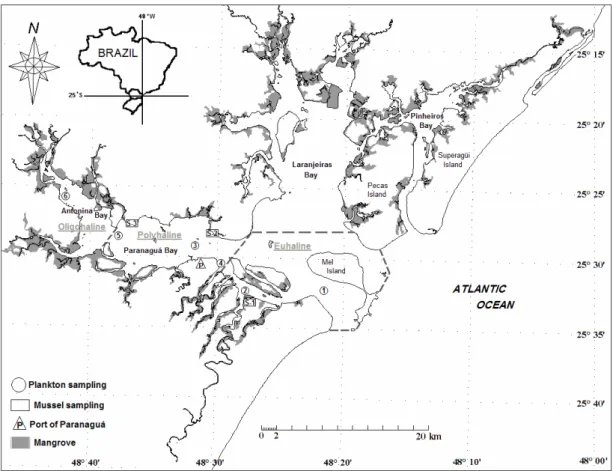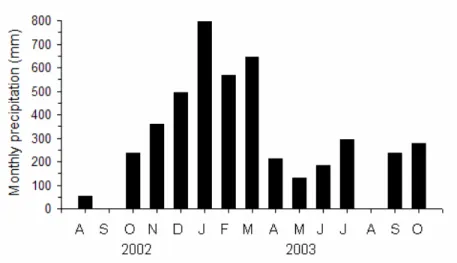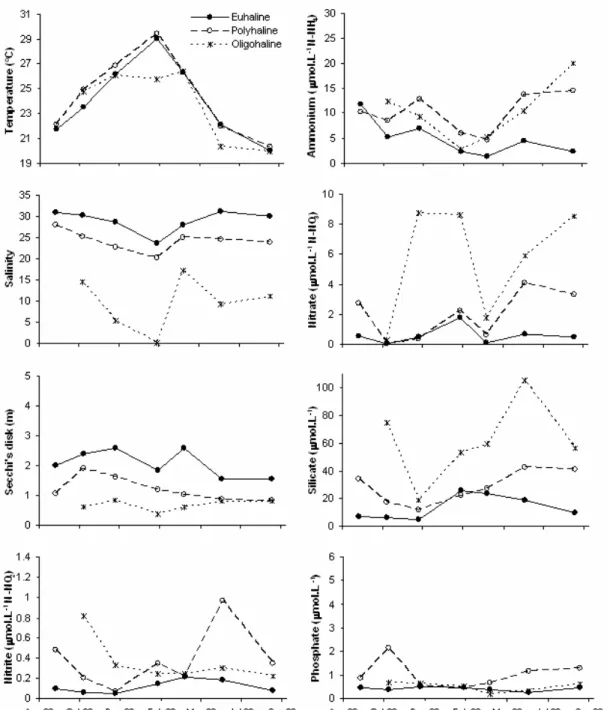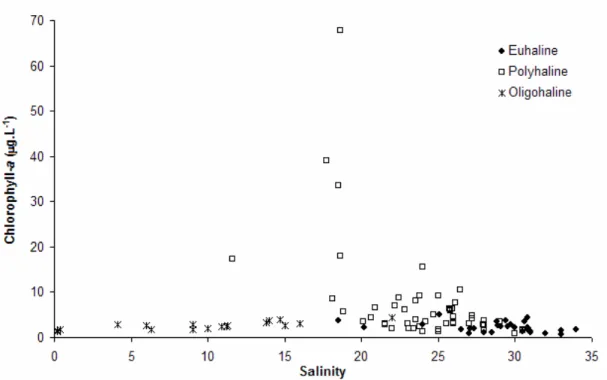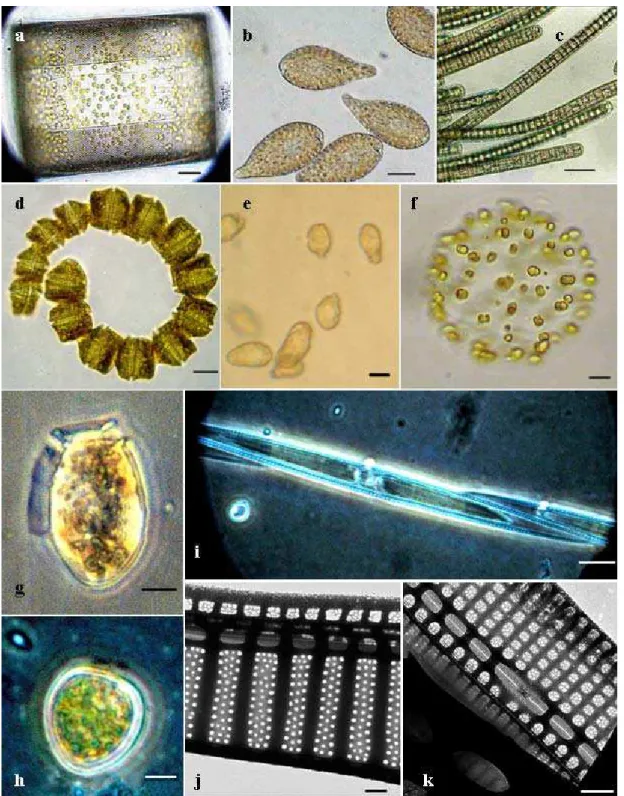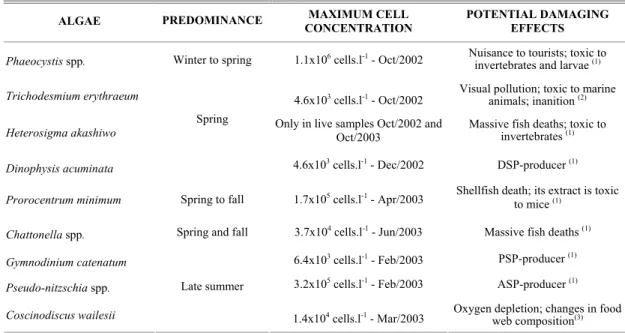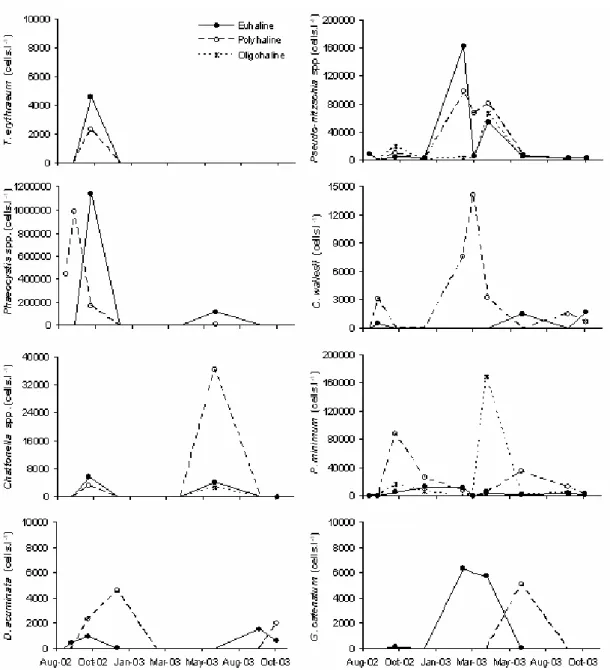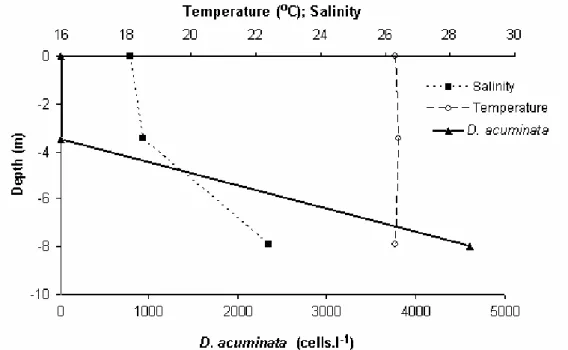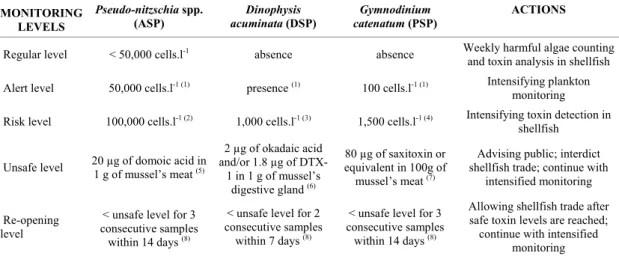BRAZILIAN JOURNAL OF OCEANOGRAPHY, 54(1/2):107-121, 2006
HARMFUL ALGAE AND TOXINS IN PARANAGUÁ BAY, BRAZIL:
BASES FOR MONITORING
Luiz Laureno Mafra Junior1*, Luciano Felício Fernandes2 & Luís Antonio O. Proença1
1
Universidade do Vale do Itajaí
Centro de Ciências Tecnológicas da Terra e do Mar, CTTMar (Rua Uruguai, 458, 88302-202, Itajaí, SC, Brasil) *Corresponding author: luiz.mafra@nrc-cnrc.gc.ca
2
Universidade Federal do Paraná, Departamento de Botânica Setor de Ciências Biológicas, Centro Politécnico
(Caixa Postal 19031, Jardim das Américas - 81531-970, Curitiba, Paraná, Brasil)
A
B S T R A C TThe estuarine complex of Paranaguá – ECP (South Brazil, 25º30’S, 48º30’W) is a large subtropical system, where pristine mangrove forests are still present, and fishery and aquaculture are important economic activities. This work investigated the occurrence of harmful algae in Paranaguá Bay, as well as the presence of toxins in the filter feeding mussel Mytella guyanensis, a local fishery resource. Samples along the Paranaguá sub-system were collected almost monthly from August 2002 to October 2003. Besides physical and chemical variables, cell densities of harmful species and presence of toxins in the mussel by mouse bioassay (DSP, PSP) and HPLC (ASP) were performed. HAB species included Pseudo-nitzschia spp., Dinophysis acuminata, Prorocentrum minimum,
Gymnodinium catenatum, Phaeocystis spp., Chattonella spp. and Heterosigma akashiwo.
Trichodesmium erythraeum and Coscinodiscus wailesii were also included in this study due to their potential for harmful bloom formation. Toxin results showed the occurrence of DSP (December 2002) in shellfish related to the presence of D. acuminata (max. 4,566 cells.l-1). Additionally, cultivated strains produced paralytic and amnesic toxins in laboratory. Spring (October to December, Southern Hemisphere) and late summer (February to April) were the periods of higher abundance of harmful algae, mainly in euhaline and inner polyhaline sectors of the ECP.
R
E S U M OO complexo estuarino de Paranaguá (CEP; 25º30’S, 48º30’W), localizado no litoral sul do Brasil, abriga extensas áreas preservadas de manguezais e tem a pesca e aqüicultura como importantes atividades econômicas. Este trabalho investigou a ocorrência de microalgas nocivas no CEP e a presença de ficotoxinas no molusco bivalve Mytella guyanensis. Para tanto, foram coletadas amostras com periodicidade aproximadamente mensal, entre agosto de 2002 e outubro de 2003. Foram avaliadas variáveis físico-químicas, densidade de espécies nocivas e a presença de toxinas nos moluscos através de bioensaio com camundongos (DSP e PSP) e por cromatografia líquida (ASP). As espécies nocivas encontradas foram Pseudo-nitzschia spp., Dinophysis acuminata, Prorocentrum minimum, Gymnodinium catenatum, Phaeocystis spp., Chattonella spp. e Heterosigma akashiwo. Além dessas, Trichodesmium erythraeum e Coscinodiscus wailesii foram também incluídas no estudo pelo potencial de produzirem eventos nocivos na região. Toxinas diarréicas (DSP) foram detectadas em moluscos em dezembro de 2002 associadas à presença de D. acuminata (até 4.566 cel.l-1). Toxinas paralisantes e amnésicas foram produzidas por cepas cultivadas em laboratório. Primavera (de outubro a dezembro no hemisfério Sul) e final do verão (fevereiro a abril) foram os períodos de maior abundância de algas nocivas principalmente nos setores euhalino e polihalino interno do CEP.
Key words: Phytoplankton, Harmful Algae, Monitoring, Toxins, Mytella guyanensis, Paranaguá, South Brazil.
I
NTRODUCTIONIn spite of their significant ecological role as primary producers, algae can be injurious to the environment through events known as harmful algal blooms (HABs). This natural phenomenon is usually defined by intense growth in number of some algae in a short period of time, caused by favorable conditions, and reaching high cell densities in the water. However, in some cases, an event may be classified as a bloom even at low algal densities, if negative effects are reported (Van Dolah, 2000). For example, the dinoflagellates Pfiesteria piscicida Steidinger et Burkholder (Burkholder & Glasgow Jr., 1997) and Dinophysis spp. (Smayda, 1997) may be harmful at densities lower than 1,000 cells.l-1.
Marine harmful algae can impose different classes of damages, such as oxygen depletion by bacterial respiration during bloom decay; mortality of aquatic organisms by physical injuries or release of noxious substances; and production of toxins able to affect animals and humans by ingestion of contaminated seafood. Furthermore, HABs may impose severe economic impacts to fishery, aquaculture and tourism (Hallegraeff, 2003).
Marine phycotoxins affecting human health are grouped according to their molecular structure and manifested symptoms in humans. Up to now, toxins causative of ASP (amnesic shellfish poisoning), DSP (diarrhetic shellfish poisoning), and PSP (paralytic shellfish poisoning) were reported in Brazilian waters (Proença & Mafra Jr., 2005). Shellfish consumption is the main vector for human intoxication, since such organisms may accumulate toxins during their filter feeding process.
Symptoms in humans vary from mild to acute, depending on the toxin and ingested dosage. DSP causes diarrhea, nausea, vomiting and abdominal pain. There is no report of human death due to this poisoning, but chronic exposure may lead to formation of tumors in the digestive system (Hallegraeff, 2003). In mild cases ASP displays similar symptoms, but in extreme cases it may cause decreased reaction to deep pain, dizziness, hallucinations, confusion, short-term memory loss, and seizures. In November 1987, at least three people died and another 107 were hospitalized after ingesting mussels contaminated with amnesic toxins in Prince Edward Island, Canada (Wright et al., 1989). PSP is the most lethal group of phycotoxins, causing around 2,000 annual cases of human intoxications worldwide at a mortality rate of 15%. In gentle cases, it incites tingling sensation or numbness around lips, gradually spreading to face and neck; prickly sensation in fingertips and toes, headache, dizziness, nausea, vomiting, and diarrhea. In extreme cases, PSP causes muscular paralysis, pronounced respiratory difficulty, and shock sensation. Death
through respiratory paralysis may occur within 2 to 24 hours after ingestion of contaminated shellfish (Hallegraeff, 2003).
A DSP event was considered to date the unique official report of human intoxication caused by contaminated seafood ingestion in Brazil (Proença et al., 1999). However, several harmful algae species have been found in Brazilian waters, some of them forming blooms (Odebrecht et al., 2002; Proença & Mafra Jr., 2005). The occurrence of HABs has recently increased mainly due to coastal environment eutrophication; long-term climate changes; ineffective biological control by consumers and competitors; research’s intensification and improvement; and transport of harmful algae by oceanic currents or human activities such as aquaculture and ballast water (Hallegraeff, 2003).
The present work aimed to detect the presence and abundance of potentially harmful algae in the estuarine complex of Paranaguá (ECP), as well as to measure the possible accumulation of phycotoxins in the mussel “sururu” (Mytella guyanensis Lamarck, 1819). It also provided a base for execution of monitoring programs on harmful algae and toxins.
M
ETHODSParanaguá is a large estuarine complex (25°30’S, 48°30’W, Fig. 1) composed of four main bays: Pinheiros, Laranjeiras, Antonina, and Paranaguá, covering 612 Km² of water surface. According to Köppen´s climate classification (Köppen, 1936), the region is classified as Cfa (pluvial, wet, and average temperature of the hottest months higher than 22°C). A semidiurnal tide regime, with annual range of 2.23m, controls the local hydrodynamics. The environment is divided in oligo- to mesohaline (inner), polyhaline (intermediate), and euhaline (outer) sections, according to the range of salinity (Machado et al., 1997; Lana et al., 2001). Following the proposed classification, none of our sampling stations was characterized as mesohaline.
Ciências do Mar of Universidade Federal do Paraná (CEM/UFPR).
Water samples (200 ml) were preserved with Lugol’s acetic solution (1%), and cell counts were made in sub samples after settling in Utermöhl chambers over 24 h. Cells were counted under inverted microscope, following transversal transects until at least 300 individuals of two different species appeared, reducing the counting error to 10% (Venrick 1978). Phaeocystis spp. density was estimated by establishing a correlation between diameter of colonies and number of cells. Plankton samples (300 ml) were collected by vertical net towing (20 µm mesh), and preserved with formaldehyde solution (4%) for taxonomic analysis. Species identification was performed using optical (Olympus®IX70), scanning
(Phillips®XL30), and transmission electron (Jeol®JMI200 EXII) microscopes.
Chlorophyll-a (chl-a) was analyzed by high performance liquid chromatography (HPLC), according to the method described in Proença (2002). Concentrations of the following nutrients were measured by spectrophotometric techniques: nitrite (N-NO2), nitrate (N-NO3), and silicate as stated by
APHA (1999), and ammonium (N-NH4) and
phosphate (P-PO4) according to Strickland & Parsons
(1972). Chlorophyll-a and nutrient concentrations were expressed as an average of five samples in the euhaline sector, eight in the polyhaline, and three in the oligohaline sector.
Fig. 1. Map of the estuarine complex of Paranaguá (ECP) showing the phytoplankton (circles) and mussel Mytella guyanensis
(rectangles) sampling stations, located around the Port of Paranaguá (triangle), Brazil. Dotted lines limit the different sectors – oligohaline, polyhaline, and euhaline.
Samples (2 Kg) of mussels Mytella guyanensis were taken in three beds close to the water sampling sites (Fig. 1). After sampling, mussels were frozen for ASP, DSP and PSP toxin detection. Mussels were shucked and the edible tissues were pooled (150 g) for PSP toxins extraction according to the Association of Official Analytical Chemists’ protocol (AOAC, 1990), and using the Sommer’s table to express results in mouse units – MU (Fernández et al., 2003). Mouse bioassays were performed for toxin detection and quantification. Besides, 15 g of digestive glands were removed for DSP analysis by Yasumoto et al. (1984)’s method. After extraction, the presence of DSP toxins was tested by mouse bioassay (Yasumoto et al., 1984) and confirmed by HPLC (Pereira et al., 1995). Finally, 1 g of the digestive glands was used for ASP analysis by HPLC following the method described by Quilliam et al. (1995).
R
ESULTSEnvironmental Conditions
Rainfall was more intense during summer (December 2002 to March 2003), as in previous years. The maximum monthly rainfall was reported in January 2003 (797 mm). September 2002 (1.5 mm) and August 2003 (negligible rainfall) were the driest periods (Fig. 2).
Water column depth ranged from 2.0 to 14.2 m, being deeper in the euhaline sector (average = 8.4 m). Salinity was inversely related to the rainfall
seasonal pattern. Spatial variation in this parameter justified the division of the environment in three sections. In our study, salinity ranged from 0.2 in the oligohaline sector to 34 in the euhaline one. Water transparency was lower in the inner region and during rainy periods, when land runoff (responsible by the transport of large amounts of suspended particles) was more intense (Fig. 3). Water temperature was approximately constant among the different sectors, being slightly higher in shallow areas. Minimum temperature was reported in September 2003 and maximum in February 2003, except in the oligohaline sector, where maximum temperatures were measured in April 2003.
In general, averaged nutrient concentrations were higher in the inner and intermediate sections (Fig. 3). The maximum ammonium value was found during the winter of 2003 (36 µmol.l-1) in one sample from the polyhaline sector. Nitrite was constantly low, with values ranging from 0.03 µmol.l-1 in December 2002, euhaline sector to 1.7 µmol.l-1 in June 2003, polyhaline sector. Nitrate was higher in the oligohaline sector, reaching a maximum of 10 µmol.l-1 in December 2002. Silicate concentration was always higher in the oligohaline sector due to strong influence of freshwater discharge, with maximum concentration of 114 µmol.l-1 in June 2003. Phosphate concentration was higher near the Port of Paranaguá, in the intermediate section. In that area, an extremely high phosphate concentration (10 µmol.l-1)was measured in
an isolated sample (station 4; surface) in October 2002
Fig. 3. Physical-chemical parameters in the estuarine complex of Paranaguá (ECP), Brazil, from August 2002 to September 2003. Each point represents a mean value for each sector of the environment – euhaline (n=5), polyhaline (n=8), and oligohaline (n=3).
Chl-a was higher in the polyhaline sector, coinciding with summer Skeletonema costatum (Greville) Cleve blooms. Maximum peaks of chl-a ranged between 15.6 and 68 µg.l-1 (Fig. 4), corresponding to S. costatum densities from 2.3x106 to
2x107 cells.l-1. Chl-a concentrations were relatively low throughout the year in both euhaline (0.6 to 5 µg.l
-1
) and oligohaline sectors (1.3 to 4.3 µg.l-1), showing maximum peaks during the spring (October 2002) and summer (February and April 2003).
Fig. 4. Chlorophyll-a in function of salinity in different areas of the estuarine complex of Paranaguá (ECP), Brazil – euhaline, polyhaline, and oligohaline sectors. August 2002 to September 2003.
Harmful algae abundance
Most species discussed here (Fig. 5) are part of the harmful algae’s list elaborated by the Intergovernmental Oceanographic Commission of the UNESCO (IOC, 2003), such as the toxin producers Pseudo-nitzschia spp., Gymnodinium catenatum Graham, Dinophysis acuminata Claparède et Lachmann, and others able to damage marine organisms: Chattonella spp., Phaeocystis spp., Heterosigma akashiwo (Hada) Hada, and Prorocentrum minimum (Pavillard) Schiller. Besides those, Trichodesmium erythraeum Ehrenberg and Coscinodiscus wailesii Gran et Angst were also added to the study due to their local importance and their potential to form harmful blooms (Brandini, 1988; Fernandes et al., 2001).
Maximum densities of each harmful algae found in the ECP are summarized in the Table 1, as well as the periods of higher abundances.
Three potentially toxic Pseudo-nitzschia species were identified by electron microscopy: P. pungens (Grunow ex P.T. Cleve) Hasle, P. calliantha Lundholm et al., and P. multiseries (Hasle) Hasle. However, because their identification under optical microscope is very difficult, all species were counted
together asPseudo-nitzschia spp. They were detected along the entire sampling period, being more abundant in late summer (February 2003 to April2003), mainly in the euhaline and outer polyhaline sectors. G. catenatum occurred sporadically, concentrated in the euhaline sector. D. acuminata was only observed during the spring (October 2002 to December 2002, and September 2003 to October 2003), being more conspicuous in the inner polyhaline sector (Fig. 6).
Fig. 5. Light (a-i) and transmission electron micrographs (j-k) of harmful algae found in the Estuarine Complex of Paranaguá (ECP), Brazil. (a) Coscinodiscus wailesii; (b) Chattonella cf. marina; (c) Trichodesmium erythraeum; (d) Gymnodinium catenatum; (e) Heterosigmaakashiwo; (f) Phaeocystis globosa; (g) Dinophysisacuminata; (h) Prorocentrumminimum; (i)
Pseudo-nitzschiapungens; (j) Pseudo-nitzschiamultiseries; (k) Pseudo-nitzschia calliantha. Scale bar: 20µm (a-d); 10µm (e-g);
5µm (h-i); 0.5µm (j-k).
this dinoflagellate was more abundant in the oligohaline and inner polyhaline sectors, with maximum densities reported in April 2003 and October 2002, respectively (Fig. 6). H. akashiwo was not observed in preserved samples because its fragile cell wall is unable to tolerate common preserving solutions. However, it was found in live samples in October 2002 and October 2003, mainly in the euhaline sector. Finally, C. wailesii was more abundant in the inner polyhaline sector, mostly during the summer, while T. erythraeum was restricted to the outer areas in October 2002 (Fig. 6).
Toxins in Mytella guyanensis
One of the bioassays for toxin detection in mussels M. guyanensis revealed a positive result for DSP toxins. In such episode, two out of three mice died during the first 24 hours after the test has been applied. This toxic sample was collected in December 2002, in the inner polyhaline sector, sampling station S-3 (Fig. 1). In that same place and time, D. acuminata was found in concentrations up to 4,500 cells.l-1.
When HPLC analyses were performed to confirm the presence of DSP toxins in the positive sample, okadaic acid (OA) was not found. However, a small peak became evident at 18.4 minutes of the analysis. Such peak showed area and height directly proportional to the concentration of each analyzed sub sample.
Amnesic (ASP) and paralytic (PSP) toxins were not detected in mussels M. guyanensis, although Gymnodinium catenatum and Pseudo-nitzschia spp. were found in water samples, sometimes at relatively high densities, and isolates of both algae produced toxins when cultivated in laboratory (data not shown).
D
ISCUSSIONEnvironmental conditions and harmful algae abundance Salinity values close to zero, as recorded here in February 2003 and previously reported by Machado et al. (1997) and Lana et al. (2001), may be found in the oligohaline sectors of the Estuarine Complex of Paranaguá (ECP) after intense rainfall events. Concentrations of nutrients varied inversely to the salinity, being higher in the oligohaline sector and lower in the euhaline due to the stronger land drainage influence over the former sector. However, phosphate was higher in the polyhaline sector, confirming several previous works which have mentioned the waste matter runoff carried by the Itiberê River and the activity of a phosphate industry as potential sources of phosphate in that area (Knoppers et al., 1987; Brandini et al., 1988; Machado et al., 1997). Lower water transparency in the oligohaline sector reflects the large amount of inorganic and organic particles carried by freshwater runoff.
Table 1. Potentially harmful algae found in the estuarine complex of Paranaguá (ECP), Brazil – periods of predominance; maximum cell concentrations; and potential damaging effects. August 2002 to October 2003.
ALGAE PREDOMINANCE MAXIMUM CELL CONCENTRATION
POTENTIAL DAMAGING EFFECTS
Phaeocystis spp. Winter to spring 1.1x106 cells.l-1 - Oct/2002 Nuisance to tourists; toxic to
invertebrates and larvae (1) Trichodesmium erythraeum 4.6x103 cells.l-1 - Oct/2002 Visual pollution; toxic to marine animals; inanition (2)
Heterosigma akashiwo Only in live samples Oct/2002 and Oct/2003 Massive fish deaths; toxic to invertebrates (1)
Dinophysis acuminata
Spring
4.6x103 cells.l-1 - Dec/2002 DSP-producer (1)
Prorocentrum minimum Spring to fall 1.7x105 cells.l-1 - Apr/2003 Shellfish death; its extract is toxic to mice (1)
Chattonella spp. Spring and fall 3.7x104 cells.l-1 - Jun/2003 Massive fish deaths (1)
Gymnodinium catenatum 6.4x103 cells.l-1 - Feb/2003 PSP-producer (1)
Pseudo-nitzschia spp. 3.2x105 cells.l-1 - Feb/2003 ASP-producer (1)
Coscinodiscus wailesii
Late summer
Fig. 6. Average abundance of potentially harmful algae in different areas of the estuarine complex of Paranaguá (ECP), Brazil – euhaline, polyhaline, and oligohaline sectors. August 2002 to October 2003.
Phytoplankton growth is limited by low light penetration in the oligohaline sector, and by low nutrient concentration in the euhaline sector of the ECP, mainly by nitrogen compounds (Brandini et al., 1988; Machado et al., 1997; Lana et al., 2001). Therefore, the polyhaline sector is the most favorable area for phytoplankton growth due to the combination
adjacent continental shelf, which bears the oligotrophic Tropical Water (Brandini et al., 1988).
Similar to abundance, phytoplankton species composition also showed variations over time and amongst ECP sectors. HAB species were more frequently observed in the euhaline and inner polyhaline sectors. In the oligohaline sector, where the salinity is sometimes very low, P. minimum was the only frequent and abundant species among the potentially toxic ones. That alga has bloomed under low salinity conditions in diverse regions (e.g. Fan et al., 2003).
Spring and late summer were the periods with highest HAB abundance and diversity (Table 1). During the spring (September to December), increasing temperature may favor cyst germination and vegetative cell growth of some HAB species, such as Heterosigma akashiwo (Smayda, 1998) and Chattonella spp. (Imai et al., 1998). Rising nutrient concentrations, due to winter storage and early spring rainfalls, may also stimulate the growth of Phaeocystis spp. (Lancelot et al., 1998) and Prorocentrum minimum (Fan et al., 2003) in such period. In late summer (February to March), other HAB species like Pseudo-nitzschia spp. and G. catenatum reach their maximum cell densities (Table 1) led mainly by higher temperature and intense nutrient inputs. In early fall (April), after active nutrient consumption, and when water temperature starts to decrease, phytoplankton concentrations tend to be lower. However, that is when cold front systems can generate strong winds and waves, favoring water turbulence and removal of recycled nutrient from the bottom to the surface in the ECP (Marone & Camargo, 1994). Therefore, this possible further nutrient intake and water turbulence may be responsible for the second peak in both Pseudo-nitzschia spp. and P. minimum abundance.
In the ECP, H. akashiwo seems to be the most dangerous alga among those non-toxic to humans, due to its potential effects and reports of previous blooms in Laranjeiras Bay (Proença & Fernandes, 2004). H. akashiwo not only kills natural and cultivated fish population (Twiner & Trick, 2000), but a local strain was also able to affect the survival of juvenile misidaceans Misydopsis juniae Silva 1979 and larvae of mussels Perna perna Linnaeus 1758 (Mafra Jr., 2005, unpubl.), organisms with either ecological or economic importance in South Brazil. Therefore, damages to fishery activities in the ECP can be even increased if a bloom coincides with reproduction seasons of invertebrates, especially during the spring.
Like H. akashiwo, C. wailesii has already formed blooms in the ECP, significantly changing the food web composition due to fast nutrient and dissolved oxygen consumption (Fernandes et al., 2001). Other harmful species can also cause severe
damaging effects to the environment if a bloom occurs in the ECP area (Table 1).
Toxins in Mytella guyanensis
D. acuminata was the only DSP-producer found in our investigation. Its maximum abundance was observed in the inner polyhaline sector, December 2002; same period and place where a M. guyanensis sample showed positive result in a DSP bioassay. Probably, molluscs were contaminated by filtering D. acuminata, present in densities up to 4,500 cells.l-1. Although this concentration seems very low considering other HAB species, similar values were enough to cause DSP outbreaks in some countries, e.g. 708 cells.l-1 in Japan; 20,600 cells.l-1 in New Zealand; and 30,000 cells.l-1 in Spain (revised in Reguera, 2003, unpubl.).
In our investigation, when D. acuminata density was maximum, a saline stratification could be noticed in the inner polyhaline sector (Fig. 7). In such episode, D. acuminata was only found near the bottom. Accumulation right above thermo- or haloclines is often observed during D. acuminata bloom (e.g. Chang, 1996). This alga exhibits active vertical migration, taking advantage in situations of water column stratification. As a mixotrophic species, it may be benefited by the presence of layers with abundance of nutrients, organic matter or preys, even in the dark (Setälä et al., 2005).
The most important diarrhetic toxin produced by D. acuminata is okadaic acid (OA), but Dinophysis spp. are able to produce many other toxins, including recently discovered forms of diarrhetic toxins, such as OA’s esters, and lipophylic non diarrhetic toxins, like the pectenotoxin-11 (MacKenzie et al., 2005). Sometimes, those toxins are produced in concentrations much higher than the OA, becoming the most important source of toxicity of some Dinophysis strains. Besides toxin composition, toxicity also varies according to several environmental and seasonal conditions (MacKenzie et al., 2005). Therefore, it is possible that D. acuminata populations of the ECP produce toxins other than OA, explaining its absence in our HPLC analysis. This same combination of results was also found in Itajaí, Southern Brazil, where, sometimes, mice death in DSP bioassays has not necessarily been associated to OA presence (L.A.O. Proença, UNIVALI, pers. comm.).
without specific standards for the referred toxins. Another possibility is the DTX3, a toxin hypothetically converted from OA and its congeners inside shellfish tissues (Susuki et al., 1999). Furthermore, mice death could be caused either by interfering substances or non-diarrhetic toxins, such as pectenotoxins and yessotoxins, which can be extracted together with OA and DTX.
The amnesic toxin domoic acid was not detected in our mussel samples, although one Pseudo-nitzschia cf. multiseries strain has produced amnesic toxins in culture (Mafra Jr., 2005, unpubl.), and some potentially toxic Pseudo-nitzschia species have been found in the ECP, sometimes at high cell densities. Factors possibly explaining the absence of ASP toxins in mussel samples include: (a) high cell density required to contaminate shellfish at prohibitive levels for human consumption (at least 100,000 cells.l-1, Bates et al., 1998); (b) simultaneous counting of toxic and non-toxic Pseudo-nitzschia species; (c) low toxicity of local Pseudo-nitzschia strains (Mafra Jr., 2005, unpubl.); (d) low relative concentration of Pseudo-nitzschia related to the total phytoplankton counting (up to 11.2%); and (e) the absence of M. guyanensis beds in areas where Pseudo-nitzschia spp. were more abundant. Densities higher than 300,000 cells.l-1 of Pseudo-nitzschia spp. were detected in the ECP. Hence, those cells were either low toxic and/or accounted only for a small fraction of the mussel’s food intake, since in Spain a similar concentration of
P. australis (450,000 cells.l-1) was sufficient to contaminate mussels until unsafe levels of domoic acid (Míguez et al., 1996).
Paralytic toxins were not detected either. Although G. catenatum strains have been toxic in culture (Mafra Jr., 2005, unpubl.), constant low densities of this alga may explain the absence of paralytic toxins in M. guyanensis during the investigated period.
Bases for monitoring
The presence of several potentially harmful algal species poses a threat to the ECP ecosystem and fishery activities. Blooms like the H. akashiwo outbreak in 2001 (Proença & Fernandes, 2004) can cause severe injuries for marine organisms and humans, damaging fishery, aquaculture, and tourism. This situation is intensified by the occurrence of ASP, DSP, and PSP-producer species, as well as by the recent increase in shellfish harvesting and culture, enhancing the probability for human intoxications. The predominance of these algae during the spring and summer, when many tourists travel to the ECP area, also increases the risk of human intoxication episodes. The lack of a monitoring program for toxins and harmful algae makes the ECP extremely susceptible to destructive effects of forthcoming HAB events.
Our results lead to recommend the execution of a harmful algae and toxin monitoring plan, emphasizing the critical sectors of the ECP, besides others with intense fishery, harvesting and aquaculture activities. As the success of a monitoring program depends on its sampling frequency, weekly sampling would be recommended, but numerous samples and long distances could make difficult to reach this goal. Phytoplankton counting alone is not able to safely forecast the occurrence of harmful outbreaks; it is imperative to continuously monitor for toxin levels in shellfish. However, counting of potentially toxic species is a practical tool that may act as a first signal of intoxication episodes.
Based on present and previous data, an action plan is here proposed (Table 2), taking into consideration cell densities of the toxic algae found in the ECP, as well as toxin levels in shellfish. Harmful algae and toxins must be continuously monitored, but efforts should be intensified when cell densities and toxin levels reach predefined values for each intoxication. Intensification includes shortening sampling intervals, or even increasing the number of sampling stations, whenever is possible. If prohibitive toxin levels were reached (Table 2), authorities in charge must alert the public, hospitals and health clinics, which must be attentive for the occurrence of characteristic symptomatology.
Diarrhetic poisonings are able to produce symptoms under low dosages of toxin; gastric disturbances can be manifested after intake of 48 to 75 µg of okadaic acid (Vale & Sampayo, 2002). On the other hand, PSP symptoms are displayed after intake of 1 to 4 mg of saxitoxin (Schantz, 1984), and ASP
only after ingestion of as high dosages as 60 to 110 mg of domoic acid (Todd, 1993). Because of that and the large cell size and high toxin levels of the DSP-producer D. acuminata, action plans have designated extremely restrictive levels for DSP monitoring (Table 2).
When monitoring the presence of the PSP-producer G. catenatum, one must sample the whole water column, since this dinoflagellate is very active and may exhibit a fast vertical migration, excluding competitors and extending its persistence during blooms (Clementson et al., 2004). Cell number in the chains formed by this alga must also be observed. Long chains (32 to 64 cells) are an indicative of actively growing populations, with increasing toxicity (Gárate-Lizárraga et al., 2004). Mouse bioassays are still useful for PSP detection, as complete analysis by HPLC comprises 24 different congeners, including the recently discovered GC toxins (Llewellyn et al., 2004).
Therefore, a monitoring program in the ECP must have D. acuminata, G. catenatum, and Pseudo-nitzschia spp. as the main targets, but the possibility for new occurrences of toxic species cannot be discarded. Either oceanic and coastal currents or human activities, such as aquaculture and ship’s ballast water, may transport new harmful species to the ECP, or even strains more toxic of the already established species. Some species represent a real risk, such as several other Dinophysis spp. previously detected in Brazilian waters (revised in Proença & Mafra Jr., 2005), and the PSP-producer Alexandrium tamarense (Lebour) Balech, which was already found in the ECP (L.F. Fernandes, UFPR, pers. comm.).
Table 2. Proposed action plan for ASP, DSP and PSP monitoring in the estuarine complex of Paranaguá, Brazil, based on harmful algae counting and toxin levels in shellfish.
MONITORING LEVELS
Pseudo-nitzschia spp.
(ASP)
Dinophysis
acuminata (DSP)
Gymnodinium
catenatum (PSP)
ACTIONS
Regular level < 50,000 cells.l-1 absence absence Weekly harmful algae counting and toxin analysis in shellfish Alert level 50,000 cells.l-1 (1) presence (1) 100 cells.l-1 (1) Intensifying plankton monitoring Risk level 100,000 cells.l-1 (2) 1,000 cells.l-1 (3) 1,500 cells.l-1 (4) Intensifying toxin detection in
shellfish
Unsafe level 20 µg of domoic acid in 1 g of mussel’s meat (5)
2 µg of okadaic acid and/or 1.8 µg of
DTX-1 in DTX-1 g of mussel’s digestive gland (6)
80 µg of saxitoxin or equivalent in 100g of
mussel’s meat (7)
Advising public; interdict shellfish trade; continue with
intensified monitoring
Re-opening level
< unsafe level for 3 consecutive samples
within 14 days (8)
< unsafe level for 2 consecutive samples within 7 days (8)
< unsafe level for 3 consecutive samples within 14 days (8)
Allowing shellfish trade after safe toxin levels are reached; continue with intensified
monitoring SOURCES: (1) Anderson et al., 2001; (2) Bates et al., 1998; (3) Reguera, 2003; (4) Proença et al., UNIVALI, pers. comm.;
Only the implementation of monitoring programs will allow us to identify the problems related to the presence of harmful algae and toxins in any place, as well as to find out ways to prevent and mitigate their damaging effects.
A
CKNOWLEDGEMENTSThe authors thank MMA/FNMA by the financial support granted to the ALARME Project (FNMA/PROBIO n. CVI 008/2002), in which this work was inserted. We also thank CAPES by the scholarships granted to L. L. Mafra Jr. Our gratefulness to Lício Domit (IBAMA, Paranaguá), Ivanildo Soares da Silva (EMATER), and to all members of the ALARME Project by their helpful support during sampling operations, and to Letícia Procopiak by plankton counting assistance. We also thank two anonymous reviewers for helpful comments on the manuscript.
R
EFERENCESAnderson, D. M.; Andersen, P.; Bricelj, V. M.; Cullen, J. J.; Rensel, J. E. 2001. Monitoring and management strategies for Harmful Algal Blooms in Coastal Waters, APEC # 201-MR-01.1 (IOC Technical Series No. 59). Paris, IOC-UNESCO. 268p.
AOAC. 1990. Paralytic shellfish poison: Biological method. Final Action. In: Hellrich, K. ed. Official Methods of Analysis. Arlington, Association of Official Analytical Chemists. p. 881-882.
APHA - American Public Health Association/ AWWA - American Water Works Association/ WEF – Water Environmental Federation. 1999. Standard Methods for the Examination of Water and Wastewater. 20th. ed. Washington, D.C., American Public Health Association. 1220p.
Bates, S. S.; Garrison, D. L.; Horner, R. A. 1998. Bloom dynamics and physiology of domoic acid-producing
Pseudo-nitzschia species. In: Anderson, D. M.;
Cembella, A. D.; Hallegraeff, G. M. eds. Physiological Ecology of Harmful Algal Blooms. Heidelberg, Springer-Verlag. p. 267-292.
Brandini, F. P. 1988. Composição e distribuição do fitoplâncton na região Sueste do Brasil e suas relações com as massas de água (Operação Sueste – julho/agosto 1982). Ciência e Cultura, v. 40(4):334-341.
Brandini, F. P.; Thamm, C. A.; Ventura, I. 1988. Ecological Studies in the Bay of Paranaguá. III. Seasonal and Spatial Variations of Nutrients and Chlorophyll-a. Nerítica, 3(1):1-30.
Burkholder, J. M. & Glasgow Jr., H. B. 1997. Trophic controls on stage transformations of a toxic
amnush-predator dinoflagellate. J. Eukariot. Microbiol., 44(3):200-205.
Chang, F. H. 1996. Distribution and abundance of Dinophysis acuminata (Dinophyceae) and Pseudonitzschia australis
(Bacillariophyceae) in Kenepuru and Pelorus Sounds, New Zealand. In: Yasumoto, T.; Oshima,Y.; Fukuyo, Y. eds. Harmful and toxic algal blooms. Paris, UNESCO. p. 93-96.
Clementson, L. A.; Parslow, J. S.; Turnbull, A. R.; Bonham, P. I. 2004. Properties of light absorption in a highly coloured estuarine system in south-east Australia which is prone to blooms of the toxic dinoflagellate
Gymnodinium catenatum. Estuar. Coast. Shelf Sci., 60(1):101-112.
Fan, C.; Glibert, P. M.; Burkholder, J. M. 2003. Characterization of the affinity for nitrogen, uptake kinetics, and environmental relationships for
Prorocentrum minimum in natural blooms and laboratory cultures. Harmful Algae, 2:283-299.
Fernandes, L. F.; Zehnder-Alves, L.; Bassfeld, J. 2001. The recently established diatom Coscinodiscus wailesii
(Coscinodiscales, Bacillariophyta) in Brazilian waters. I. Remarks on morphology and distribution. Phycol. Res., 49:89-96.
Fernández, M. L.; Richard, D. J. A.; Cembella, A. D. 2003.
In vivo assays for phycotoxins. In: Hallegraeff, G. M.; Anderson, D. M.; Cembella, A. D. eds. Manual on Harmful Marine Microalgae – Monographs on oceanographic methodology 11. 2nd. ed. Paris, UNESCO. p. 347-380.
Gárate-Lizárraga, I.; Bustillos-Gusman, J. J.; Alonso-Rodriguez, R.; Luckas, B. 2004. Comparative paralytic shellfish toxin profiles in two marine bivalves during outbreaks of Gymnodinium catenatum (Dinophyceae) in the Gulf of California. Mar. Pollut. Bull., 48:378-402. Hallegraeff, G. M. 2003. Harmful Algal Blooms: a global
overview. In: Hallegraeff, G. M.; Anderson, D. M.; Cembella, A. D. eds. Manual on Harmful Marine Microalgae – Monographs on oceanographic methodology 11. 2nd. ed. Paris, UNESCO. p. 25-50. Holmes, R. W. 1970. The Secchi disk in turbid coastal zones.
Limnol. Oceanogr., 31:688-694.
Imai, I.; Yamaguchi, M.; Watanabe, M. 1998. Ecophysiology, life cycle, and bloom dynamics of
Chattonella in the Seto Inland Sea, Japan. In: Anderson, D. M.; Cembella, A. D.; Hallegraeff, G. M. eds. Physiological Ecology of Harmful Algal Blooms. Heidelberg, Springer-Verlag. p. 95-111.
IOC Taxonomic Reference List of Toxic Plankton Algae. In: Intergovernmental Oceanographic Commission. http:// www.bi.ku.dk/ioc, 2003 (on-line).
Knoppers, B. A.; Brandini, F. P.; Thamm, C. A. C. 1987. Ecological studies in the Bay of Paranaguá. II. Some physical and chemical characteristics. Nerítica, 2(1):1-36.
Lana, P. C.; Marone, E.; Lopes, R. M.; Machado, E. C. 2001. The subtropical estuarine complex of Paranaguá Bay, Brazil. In: Selliger, U.; Kjerfve, P. eds. Ecological Studies, v. 144 - Coastal Marine Ecosystems of Latin America. Berlin, Springer-Verlag Berlin Heidelberg. p. 131-145.
Lancelot, C.; Keller, M. D.; Rousseau, V.; Smith Jr., W. O.; Mathot, S. 1998. Autoecology of the marine haptophyte
Phaeocystis sp. In: Anderson, D.; Cembella, A.D.; Hallegraeff, G.H. eds. Physiological Ecology of Harmful Algal Blooms: NATO ASI Series, v. G41. Berlin, Springer-Verlag Berlin Heidelberg. p. 209-224.
Lee, J. H.; Yanagi, T.; Kenma, R.; Yasumoto, T. 1987. Fluorometric determination of diarrhetic shellfish toxins by high-performance liquid chromatography. Agr. Biol. Chem., 51(3)877-881.
Llewellyn, L..; Negri, A.; Quilliam, M. 2004. High affinity for the rat brain sodium channel of newly discovered hydroxybenzoate saxitoxin analogues from the dinoflagellate Gymnodinium catenatum. Toxicon, 43:101-104.
Machado, E. C.; Daniel, C. B.; Brandini, N.; Queiroz, R. L. V. 1997. Temporal and spatial dynamics of nutrients and particulate suspended matter in Paranaguá Bay, PR, Brazil. Nerítica, 11:15-34.
MacKenzie, L.; Beuzenberg, V. Holland, P.; McNabb, P.; Suzuki, T.; Selwood, A. 2005. Pectenotoxin and okadaic acid-based toxin profiles in Dinophysis acuta and
Dinophysis acuminata from New Zealand. Harmful
Algae, 4(1):75-85.
Marone, E. & Camargo, R. 1994. Marés meteorológicas no litoral do estado do Paraná: o evento de agosto de 1993. Nerítica, 8(1-2):73-85.
Míguez, A.; Fernández, M. L.; Fraga, S. 1996. First detection of domoic acid in Galicia (NW of Spain). In: Yasumoto, T.; Oshima,Y.; Fukuyo, Y. eds. Harmful and toxic algal blooms. Paris, UNESCO. p. 143-145.
Negri, A. P.; Bunter, O.; Jones, B.; Llewellyn, L. 2004. Effects of the bloom-forming alga Trichodesmium erythraeum on the pearl oyster Pinctada máxima. Aquaculture, 232(1-4)91-102.
Odebrecht, C.; Azevedo, S. M. F. Q.; Garcia, V. M. T.; Huszar, V.; Magalhães, V. F.; Menezes, M.; Proença, L. A. O.; Rörig, L. R.; Tenenbaum, D. R.; Villac, M. C.; Yunes, J. S. 2002. Floraciones de microalgas nocivas en Brasil: estado del arte y proyectos en curso. In: Sar, E. A.; Ferrario, M. E.; Reguera, B. eds. Floraciones Algales Nocivas en el Cono Sur Americano. Vigo, Instituto Español de Oceanografia. p. 219-233.
Pereira, A. D.; Klein, D.; Sohet, K.; Houvenagel, G.; Braekman, J.C. 1995. Improvement to the HPLC-Fluorescence analysis method for the determination of acid DSP toxins. In: Lassus, P.; Arzul, G.; Erard-Le Denn, E.; Gentien, P.; Marcaillou-Le Baut, C. eds. Harmful Marine Algal Blooms. Paris, Lavoisier. p. 33-38.
Proença, L. A. O. 2002. Clorofila a do fitoplâncton em seis enseadas utilizadas para o cultivo de moluscos bivalves
no litoral de Santa Catarina. Notas Técnicas da FACIMAR, 6:33-44.
Proença, L. A. O. & Fernandes, L. F. 2004. Introdução de microalgas no ambiente marinho: impactos negativos e fatores controladores. In: Silva, J. S. V. & Souza, R. C. C. L. eds. Água de Lastro e Bioinvasão. Rio de Janeiro, Interciência. p. 77-97.
Proença, L. A. O. & Mafra Jr., L. L. 2005. Ocorrência de ficotoxinas na costa brasileira. In: Reunião Brasileira de Ficologia, X. 2004. Anais. (Série Livros do Museu Nacional; 10). Rio de Janeiro, Museu Nacional. p. 57-77. Proença, L. A. O.; Schmit, F.; Tamanaha, M.S.; Guimarães, S.; Rörig, L. 1999. Produção de ácido okadaico, uma toxina diarréica, por Dinophysis acuminata em Santa Catarina. Atlântica, 21:121-127.
Quilliam, M. A.; Xie, M.; Hardstaff, W. R. 1995. A rapid extraction and cleanup procedure for the liquid chromatographic determination of domoic acid in unsalted seafood. In: Hallegraeff, G. M.; Anderson, D. M.; Cembella, A. D. ed. Manual on Harmful Marine Microalgae. Paris, UNESCO. p. 95-112.
Schantz, E. J. 1984. Historical perspective on paralytical shellfish poisoning. In: Ragelis, M. ed. Seafood Toxins, ACS - Symposium Series 262. Washington, D.C., American Chemical Society. p. 99-111.
Setälä, O.; Autio, R.; Kuosa, H.; Rintala, J.; Ylostalo, P. 2005. Survival and photosynthetic activity of different
Dinophysis acuminata populations in the northern Baltic Sea. Harmful Algae, 4(2):337-350.
Smayda, T. J. 1997. What is a bloom? A commentary. Limnol. Oceanogr., 42:1132-1136.
Smayda, T. J. 1998. Ecophysiology and Bloom Dynamics of
Heterosigma akashiwo (Raphidophyceae). In: Anderson, D. M.; Cembella, A. D.; Hallegraeff, G. M. eds. Physiological Ecology of Harmful Algal Blooms. Heidelberg, Springer-Verlag. p. 113-131.
Strickland, J. D. H. & Parsons, T. R. 1972. A Practical Handbook of Seawater Analysis. 2nd ed. Ottawa, Fish. Res. Bd. Can., 310 p.
Susuki, T.; Ota, H.; Yamasaki, M. 1999. Direct evidence of transformation of dinophysistoxin-1 to 7-O-acyl-dinophysistoxin-1(dinophysistoxin-3) in the scallop
Patinopecten yessoensis. Toxicon, 37:187-198.
Todd, E. C. D. 1993. Domoic acid and amnesic shellfish poisoning – A review. J. Food Prot., 56:69-83.
Todd, K. 2003. Role of phytoplankton monitoring in marine biotoxin programmes. In: Hallegraeff, G. M.; Anderson, D. M.; Cembella, A. D. eds. Manual on Harmful Marine Microalgae – Monographs on oceanographic methodology 11. 2nd. ed. Paris, UNESCO. p. 649-656. Twiner, M. J. & Trick, C. G. 2000. Possible physiological
mechanisms for production of hydrogen peroxide by the ichthyotoxic flagellate Heterosigma akashiwo. J. Plankt. Res., 22:1961-1975.
detection of okadaic acid esters in phytoplankton. Toxicon, 40(7)989-996.
Van Dolah, F. M. 2000. Marine algal toxins: Origins, health effects, and their increased occurrence. Environm. Health Perspect., 108(1):133-141.
Venrick, E. L. 1978. How many cells to count? Monogr. Oceanogr. Methodol., 6:167-180.
Wright, J. L. C.; Boyd, R. K.; de Freitas, A. S. W; Falk, M.; Foxall, R. A.; Jamieson, W. D.; Laycock, M. V.; McCulloch, A. W.; McInnes, A. G. 1989. Identification of domoic acid, a neuroexcitatory amino acid, in toxic mussels from eastern Prince Edward Island. Can. J.Chem., 67(3):481-490.
Yasumoto, T.; Murata, M.; Oshima, Y.; Matsumoto, G. K.; Clardy, J. 1984. Diarrhetic shellfish poisoning. In: Ragelis, E. P. ed. Seafood toxins, ACS Symposium Series, 262. Washington, D.C., American Chemical Society. p. 207-214.
Sources of Unpublished Material
Mafra Jr., L. L. 2005. Microalgas nocivas e ficotoxinas no complexo estuarino de Paranaguá: subsídios para o monitoramento. M.Sc. Thesis, Departamento de Botânica, Universidade Federal do Paraná, 156p. Reguera, B. 2003. Biología, autoecología y toxinología de las
principales especies del género Dinophysis, associadas a episodios de intoxicacíon diarreogénica por bivalvos (DSP). PhD. Thesis, Departamento de Ecología, Universidad de Barcelona, 298p.
(Manuscript received 15 August 2005; revised
05 October 2005; accepted 25 April 2006)
